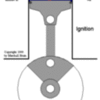Hi Doug,
My thoughts on the stroker kits are not influenced by the Cleveland’s thin cylinder walls, but rather by the wrist pin location on the piston and the rod to stroke ratio. The cylinder wall issue is indeed a consideration, but that is the case even with an oem stroke motor. Another consideration with stroker crankshafts is the width of the block and the height of the camshaft. In the case of the 351C and the 351W, there is plenty of clearance for the longer stroke crankshafts. The final consideration is how far out of the bore the piston is yanked at BDC. With the longer stroke crankshafts, the answer is pretty far, but livable.
You're an old Cleveland guy, so I don't need to explain in depth that our beloved Cleveland motor has a big ol' notch in the piston dome for intake valve clearance. That notch limits how high the ring package can be located on the piston. This in turn limits how high the wrist pin hole can be located before it intersects the oil ring groove. Some owners/builders have no problem with the wrist pin intersecting the oil ring groove. Personally, I do. It results in excessive oil consumption. For a strictly track motor, or a show car, that's OK I guess, but for a street motor, I disagree. A fellow should be able to go on a trip in his car without having to carry 3 quarts of oil in the trunk.
So, if the criterion is keeping the wrist pin below the oil ring groove, we have to consider crank stroke, connecting rod length, deck height, compression height (wrist pin center to piston dome), rod length to stroke ratio, availability and cost of parts verses custom ordered parts, etc.
I come from the prehistoric era, when running a solid lifter cam in a 3.5" stroke motor was normally accompanied with a 6.0" long connecting rod, for a connecting rod to stroke ratio of 1.7:1. A minimum ratio for a performance motor was considered 1.55:1. However, with the advent of inexpensive stroker cranks, that whole issue has been blown wide open. Some well known engine builders still prefer a longer rod to stroke ratio, but others, some very big names, say it isn't that important. Scat has the best reputation among the inexpensive stroker crankshaft providers. Below is a list of their popular kits & the various dimensions.
stroke.... rod length.... pin height.... r/s ratio
3.75……....…6.00…........….1.325…........…1.6:1
3.85…....……6.00…....…......1.275….........1.55:1
4.00…....……6.00……..........1.200….........1.5:1
The wrist pin of the 4.0” stroke kit intersects the oil ring groove, that kit also has a connecting rod length to stroke ratio that is less than what some builders consider minimal. Bob at Scat cranks has told me he feels the rod to stroke ratio of his 4.00” kit changes the high rpm characteristics of the motor. I would also say that 4.00” is a prudent limit when it is considered how far the piston is pulled out of the bore at BDC.
So the 3.85 kit is the longest stroke kit you can purchase “off the shelf” that avoids the issues of wrist pin location and rod length to stroke ratio. It is a reasonable kit, not quite as radical as the 4.00” stroke crankshaft. That is why you have read me recommend it a few times. I don’t have a problem with the longer 4.00” stroke crankshaft, as long as it is given the budget it deserves to do it right.
Where money is not the issue, there are things that can be done to get around the wrist pin location problem while using the 4.00” stroke crankshaft. For instance, building a motor with Yates heads will do away with the need for the big notch in the piston; you can shove the ring package higher, and keep the wrist pin out of the oil ring groove. A custom set of 5.925” long connecting rods will allow the use of the pistons from the 3.85” kit, with the 4.00” stroke crankshaft. While this keeps the wrist pin out of the oil ring groove, the resulting rod to stroke ratio is 1.48:1. Although some engine builders would shake their heads at this ratio, others would not. It is the same ratio as the oem 400 cubic inch small block Chevy. A third solution is to carefully map valve to piston clearance near TDC, and choose camshaft lobe profiles that will prevent valve to piston contact with little or no notch in the piston dome. This would allow the location of the rings to sit higher on the piston, keeping the wrist pin out of the oil ring groove.
In considering the thin cylinder walls, the “failure factor” all boils down to how the motor will be used, the red line of the motor, how much power the motor shall make, how well the motor is tuned, etc, etc….These days, most guys fill the block with grout to the bottom of the water pump passages which is roughly 2 ¾” below the deck. My advice would be to fill no higher than the piston dome at BDC. The grout strengthens the cylinder walls, prevents them from flexing as much, improves ring seal (from less wall flexing) and makes more power as well as improving the blocks durability. Cylinder wall failure has led some engine builders to take the position that 3.75” or 3.85” stroke kits are a prudent limit.
Other things that can be done to reduce stresses on the block, are to employ a lightened crankshaft, lightened connecting rods (I beams not H beams) and lightened pistons; and then have the reciprocating assembly dynamically balanced. I recommend taking these steps with all stroker crankshaft installations, and even more so with that longer 4.00” stroke crankshaft.
Strokin’ it with my buddies on the DTBB



